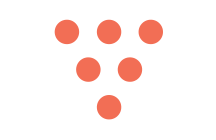
Wine has been made in France for thousands of years, and we owe many of the winemaking breakthroughs to French winemakers. The country has a staggering amount of fine wine appellations, producing some of the most prized wines on earth. You can find red and white Premier Cru Bordeaux blends (Cabernet Franc, Sémillon, Merlot, Cabernet Sauvignon, Sauvignon Blanc) and Grand Cru Burgundy (Pinot Noir, Chardonnay) wines commanding wildly high prices. Some French grape varieties on the verge of extinction have been saved by international popularity. Malbec was uprooted in Cahors, but the popularity of Malbec from Argentina saved the grapes south of Bordeaux. Trends in the wine world work in both directions.
What are the most popular French Wines?
From Brut Champagne in the north to Provençal rosé in the south, French winemakers have invented and inspired winemakers around the world to push the boundaries of wine production. Styles pioneered in Beaujolais, the Loire Valley, the Rhône Valley, Alsace, and other long-established French wine regions have spread to the new world, and it's not uncommon to see grape varieties like Grenache, Syrah, and Mourvèdre appearing together in a Southern Rhône-style blend from California or Australia. Alsatian Riesling and Gewürztraminer hold sway across the border with Germany. The influence isn't limited to still red and white wines. Sparkling wines inspired by Champagne are made all over the wine world.
What are the flavor profiles of wines from France?
The flavor profiles of French wine are obviously going to depend on what wine region it comes from and the grape varieties in it. Most French winemakers aim to express the terroir (the “somewhere-ness”) of a vineyard. Great domaines treat varietal wines uniquely, doing whatever is best for that specific grape on that specific site. With no prescriptive profile, it's important to read up on what wine from a given AOC should taste like. Chablis is made from Chardonnay and comes in a variety of styles, but is often crisp with high minerality and citrus. Chenin Blanc from the Loire is full of ripe tree fruit like pear, apple, and quince. Rosé from Provence (or Languedoc-Roussillon) has beautiful high acidity and bursting fruit flavors. Some profiles can get quite technical. For example, there is a marked difference between Left Bank (St-Estèphe, Pauillac, St-Julien, and Margaux) and Right Bank (Pomerol and St-Emilion) Bordeaux wines. Sauternes is a dessert wine from Bordeaux but is distinct from Vouvray that is made only a few hundred miles away in the Loire Valley. The Rhône region is also diverse, and the red wines of Chateauneuf-du-Pape will be different from Hermitage, Côte Rotie, and Côtes du Rhône. With so much wine to explore, you could spend a lifetime zeroing in on Gamay from Beaujolais Nouveau or Brut Champagne from Reims, but one of the most beautiful things about French wine is its diversity.
Want to learn more about wines from France?
Want to learn more about wine? Check out Wine School, where wine drinkers of all levels can learn more about their favorite wines.